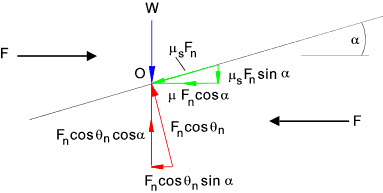| |
Power screw Page Power Screw Equations
|
Introduction
This page includes notes, figures and equations relevant to calculating the torque required to operate powers screws when used as lifting or moving machines. Notation
θ = Thread angle ...(radians) Note: These notes have been based on W being a vertical force i.e a wieght is being lifted or lowered . As an example a 1000kg mass would result in a vertical load of 1000.g = 9810 N. . The equations are equally valid if the Force (W) is simply an axial force along the screw axis Torque/ Efficiency equations for Power Screws Torque equations for Power Screws
Consider a Force F applied at a mean radius rm which causes the load to be raised. The nut is turning the screw is prevented from turning.
The sketch above identifies the reactive forces acting at point O on the screw thread surface.
The sketch below illustrates the horizontal and vertical forces acting
at a representative point at a radius r m in the plane normal to the radius.
Summing the forces in the vertical direction results in. Fn cos θncos α = W + Ff sin α The coefficient of friction for the screw surface materials is μs : Ff = μs.Fn and therefore. Fn = W / ( cosθncos α - μs.sin α )..........Equation A Summing the moment of the forces around the centerline of the screw to obtain TR , the torque to raise the load W up the incline of the screw. T R = F.r m = r m.(F f cos α + F n cos θnsin α ) = r m.(μs.F n. cos α + F n cos θnsin α )
There is an additional friction torque resulting from the friction force on the thrust collar see
top sketch above. This friction force = μc. W.
( μc = coefficient of friction between the screw thrust surface and the collar surface.). This friction
torque is assumed to be acting at the thrust collar mean radius rmc
T R = r m.(μ s.F n cos α + F n cos θnsin α ) + rmc.μc. W Substituting for Fn.. see equation A above and replacing rm by dm/2 ..( and rmc by dmc /2 )
dividing the first term numerator and denominator by cos α results in..
Tr = the torque in Nm to lift the load W (N)//
BC = AE = OA tan θ = (OB cosα). tanθ
..therefore
For many applications the helix angle is small compared to the thread angle and therefore
cos α is approximately equal to 1. e.g. For M20 2.5 pitch the value of cos α = 0.999
The torque to lower the load is written as follows
These equations can be expressed in terms of the lead by substituting the relationship tan α =
l / (θ.dm )
For applications where the thrust is taken on ball or roller thrust bearing the value of μc is sufficiently low that it can be taken as approximately 0 and therefore the second term can be ignored. The approximate equations reduce to..
Overhauling
Overhauling occurs when the screw helix angle is such that the load W would
cause to screw to rotate when the rotating force F = zero i.e. the Force is not only
required to raise the load - it is also required to statically support the load .
If the thrust collar torque is assumed to be near zero then the helix angle which allows overhauling (To = < zero) can be solved. tan α = < μs / cos θn Screw Efficiency The efficiency of a screw thread (Forward-Raising)can be defined as follows η = Torque to raise load (zero friction) / Torque to raise load Using equation B above the value of TR resulting when μs = 0 = Dividing this by equation B to provides an equation for the efficiency of the power screw thread.
If the collar friction is very low compared to the screw friction the equation reduces to
Values of μs and μc are found on the friction coefficients page of this website Power screw friction factors The efficiency of a screw thread (Backdriving -Lowering)can be defined as follows η = Back torque generated /Back Torque generated (zero friction) Using equation C above the value of TR resulting when μs = 0 = Dividing equation C by this equation provides an equation for the efficiency of the power screw thread. If the collar friction is very low compared to the screw friction the equation reduces to
Values of μs and μc are found on the friction coefficients page of this website Power screw friction factors |
Links to Power Screw Design
|
|
Power screw Page








